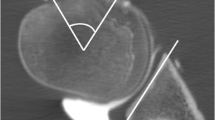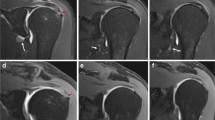Abstract
Objective
Post-operative shoulder patients are often difficult to image due to scar tissue, metallic artifact, and residual irregularity of anatomic structures. The purpose of this study was to assess MR versus MR arthrography versus CT arthrography in the post-operative shoulder. Also, we assessed whether injecting CT contrast in addition to MR contrast during arthrography improved patient care.
Methods and materials
One hundred consecutive post-operative conventional shoulder MR and MR arthrography exams performed on the same patients were reviewed retrospectively by two musculoskeletal radiologists. A combination of gadolinium and CT contrast was injected at arthrography so CT imaging could be performed post arthrography if metallic artifact precluded MR imaging. Twenty-two of these patients also had CT exams performed post-arthrography due to metallic artifact on MR exam. Exams were assessed for labral tears and supraspinatus tendon tears. All patients went on to arthroscopy.
Results
Of these 100 patients, 35 had SLAP (superior labral anterior to posterior) tears, 22 had posterior labral tears, 24 had anterior labral tears, and 46 had full-thickness supraspinatus tendon tears on conventional MR exam. On MR arthrography, 48 patients had SLAP tears, 26 had posterior labral tears, 27 had anterior labral tears, and 54 had full-thickness supraspinatus tendon tears. MR arthrogram detected 12 SLAP tears, three posterior labral tears, three anterior labral tears, and nine supraspinatus tendon tears not detected on conventional MR exam. Twenty-two patients had additional imaging performed with CT arthrography due to metallic artifacts precluding MR assessment of shoulder pathology. There were four SLAP tears, six posterior labral tears, five anterior labral tears, and five supraspinatus tendon tear seen on CT arthrography not seen on MR exam.
Conclusions
MR arthrography is more accurate than conventional MR in assessment of post-operative shoulder pathology. CT arthrography can detect additional pathology when there is metallic artifact in post-operative patients. It is beneficial to inject a combination of gadolinium and CT contrast at arthrography so CT imaging can be performed post-arthrography if metallic artifact precludes imaging shoulder pathology by MR.






Similar content being viewed by others
References
Probyn LJ, White LM, Salonen DC, Tomlinson G, Boynton EL. Recurrent symptoms after shoulder instability repair: direct MR arthrographic assessment—correlation with second-look surgical evaluation. Radiology. 2007;245(3):814–23.
Bancroft LW, Wasyliw C, Pettis C, Farley T. Postoperative shoulder magnetic resonance imaging. Magn Reson Imaging Clinic N Am. 2012;20:313–25.
Beltran LS, Bencardino JT, Steinbach LS. Postoperative MRI of the shoulder. JMRI. 2014;40:1280–97.
Zanetti M, Hodler J. MR imaging of the shoulder after surgery. Magn Reson Imaging Clin N Am. 2004;12:169–83.
Magee T. 3-T MRI of the shoulder: is MR arthrography necessary? AJR. 2009;192:86–92.
Magee T. MR versus MR arthrography in detection of supraspinatus tendon tears in patients without previous shoulder surgery. Skelet Radiol. 2014;43(1):43–8.
Tuite MJ, Cirillo RL, DeSmet AA, Orwin JF. Superior labrum anterior-posterior (SLAP) tears: evaluation of three MR signs on T2-weighted images. Radiology. 2000;215:841–5.
Mohana-Borges AV, Chung CB, Resnick D. MR imaging and MR arthrography of the postoperative shoulder: Spectrum of normal and abnormal findings. Radiographics. 2004;24:69–85.
Wagner SC, Schweitzer MD, Morrison WB, Fenlin JM Jr, Bartolozzi AR. Shoulder instability: accuracy of MR imaging performed after surgery in depicting recurrent injury-initial findings. Radiology. 2002;222:196–203.
Acid S, Le Corroller T, Aswad R, Pauly V, Champsaur P. Preoperative imaging of anterior shoulder instability: diagnostic effectiveness of MDCT arthrography and comparison with MR arthrography and arthroscopy. AJR. 2012;198:661–7.
Fritz J, Fishman EK, Winalski CS, Horger MS, Corl F, McFarland E, et al. MDCT arthrography of the shoulder with datasets of isotropic resolution: indications, technique, and applications. AJR. 2012;198:645–6.
Richardson ML, Petscavage JM. Verification bias: an under-recognized source of error in assessing the efficacy of MRI of the meniscii. Acad Radiol. 2011;18(11):1376–81.
Petscavage JM, Richardson ML, Carr RB. Verification bias an underrecognized source of error in assessing the efficacy of medical imaging. Acad Radiol. 2011;18(3):343–6.
Richardson ML, Petscavage JM. An interactive web-based tool for detecting verification (work-up) bias in studies of the efficacy of diagnostic imaging. Acad Radiol. 2010;17(12):1580–3.
Author information
Authors and Affiliations
Corresponding author
Ethics declarations
Conflict of interest
The authors declare that they have no conflicts of interest.
Ethical approval
All procedures performed in studies involving human participants were in accordance with the ethical standards of the institutional and/or national research committee and with the 1964 Helsinki Declaration and its later amendments or comparable ethical standards.
Additional information
This is based on a 2015 RSNA presentation.
Rights and permissions
About this article
Cite this article
Magee, T. Imaging of the post-operative shoulder: does injection of iodinated contrast in addition to MR contrast during arthrography improve diagnostic accuracy and patient throughput?. Skeletal Radiol 47, 1253–1261 (2018). https://doi.org/10.1007/s00256-018-2927-3
Received:
Revised:
Accepted:
Published:
Issue Date:
DOI: https://doi.org/10.1007/s00256-018-2927-3




